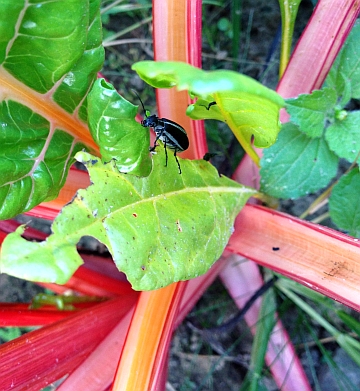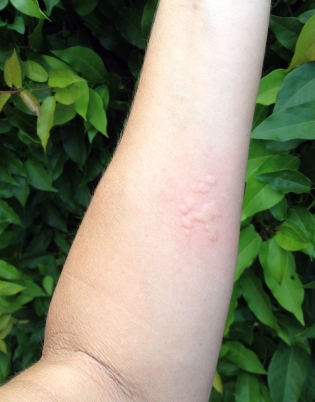I’ve had several discussions with gardening folks in the region on one of our more annoying pests, the blister beetles. Big appetite, eats lots of things we value, and darned hard to get rid of. Someone invariable says “yep, they bite, too” and “be careful – you’ll get blistered.” However, I’ve yet to hear any first-hand experience with the personal-injury aspect of blister beetles.
I’ve suffered from the heartbreak of blister beetles for two summers in a row. They’ve eaten ALL the foliage from the fall-blooming Anemone (leaving flowers on a steeck), badly damaged our chard and lettuce, and have turned their attention to the sweet-autumn clematis (Clematis terniflora).

Perp: Epicauta funebris (Margined Blister Beetle) – chock full of Cantharidin, a caustic terpenoid.
With nothing left but a mountain of bare stems, skeletonized leaves, and the occasional flower, the clematis was not adding to the general aesthetics of our home garden (unlike the 7′ tall poke weeds -whoops). I began gingerly pulling the bazillion vines off the fence, but then thought of you (yes, you). So what if one bit me or did whatever it does to cause a blister? I could then speak authoritatively instead of “I heard…”
I went at the vines with gusto, gray and black beetles a-flying. Sure enough, I mushed one against my arm in gathering up the vines toss in the cart.
Ouch. First, a burning sensation. Success! Then I watched with fascination as a bunch of welts popped out, at which point I ran and got my camera. The discomfort persisted through a couple of hours and a glass of wine. But by bedtime, my blisters were gone. No scars remain.

Oooh, lovely!
So there you have it. Yet another example of the things Garden Professors do – so you don’t have to!
Blister beetles are bad enough on people, but if horses eat enough blister beetles in their hay, it can be toxic. http://www.lsuagcenter.com/NR/rdonlyres/E53DBF6C-1B9A-4514-A579-500EA331354F/28118/AnimalHealthNotesBlisterBeetle2.pdf
Shouldn’t we be grateful to the beetle for attacking that horribly invasive and exotic C. terniflora that is stealing habitat from the wonderful, hardy and easy to grow native C. virginiana? [insert smirky smiley glyph here]
What one has to suffer for science. Are these found all over the US or go they have a limited range?
Way to go Holly! New meaning to ‘Taking one for the team’! I can’t wait for your follow-up, “Rattlesnakes: How agitated do they have to be before they strike?”
Ha, ha, Bert! I’ll get right on that. Ray, that was just naughty 😉 though I’m surprised it’s not on the VA invasive sp. list. I think it’s listed in a couple of states. I’ve actually been trying to get rid of it (plus it mugs eveythi
ng).
And Maggie’s correct – they’re all kind of trouble in forage crops. Gail, from what I can tell, there’s about 4 or 5 blister beetle species spread across N. America. There’s a brown and black striped one that’s more common than my pestie beastie. Thanks for the comments, folks!
I had the brown blister beetles that attacked my tomato plants, green beans, squash, and me!
I had the bites around my ankles & they did go away shortly. Awful things!
Thank you.
I had no idea they bit us too. We live in Southern Alberta Canda and yes we have the little pests too. I use ditomacious earth to keep them down.
Thanks a bunch for sharing this with all of us you actually understand what you’re speaking about!
Bookmarked. Kindly also consult with my site =).
We will have a hyperlink trade arrangement among us
I really hate them, I just got bit by one recently and I have a horrible blister. It’s popped and now I don’t really know what to do.